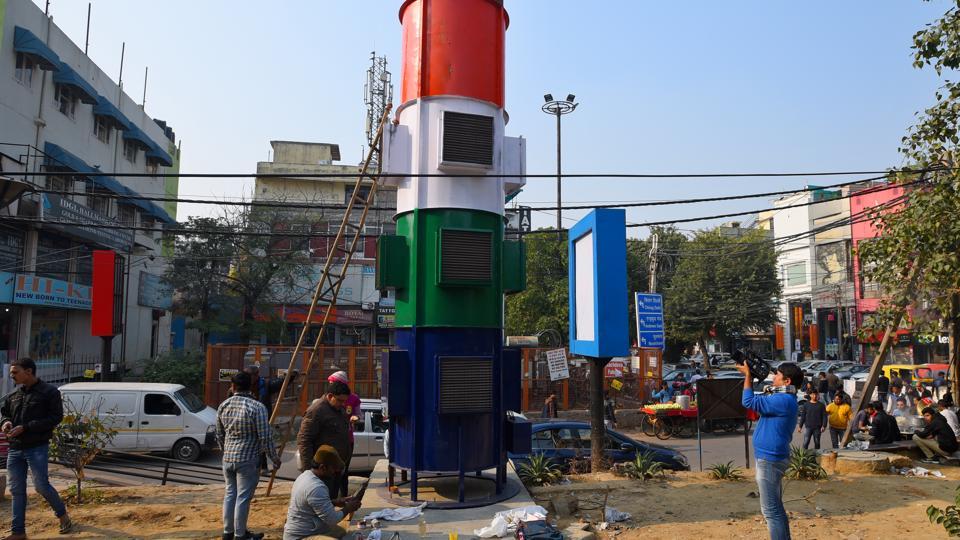Delhi gets its first smog tower to tackle air pollution
 NEW DELHI : The first ‘smog tower’ in Delhi will become operational from Friday. The giant 20-ft-tall device has been installed at south Delhi’s popular Lajpat Nagar Central Market. The “smog tower” will purify air in Lajpat Nagar market, which sees an average footfall of nearly 15,000 people every day.
NEW DELHI : The first ‘smog tower’ in Delhi will become operational from Friday. The giant 20-ft-tall device has been installed at south Delhi’s popular Lajpat Nagar Central Market. The “smog tower” will purify air in Lajpat Nagar market, which sees an average footfall of nearly 15,000 people every day.
The equipment has been installed by the Traders Association Lajpat Nagar (TALN) with the help of east Delhi MP Gautam Gambhir. The facility will be inaugurated by the cricketer-turned-politician Gambhir at noon today.
The aim is to create a “clean air zone” around the area with an estimated 80% reduction in particulate matter, as per the experts who are involved in the project. Delhi has in recent years been battling alarmingly toxic air quality every winter.
On Friday, the overall air quality index (AQI) was at 419. The concentration of pollutant particle PM10 was recorded at 399 (µgm-3) and that of PM2.5 at 269, putting Delhi’s overall AQI in the “severe” category, according to the ministry of earth sciences’ air quality monitor system of air quality and weather forecasting and research (SAFAR).
In November 2019, the supreme court directed the Modi government and the Arvind Kejriwal led-Delhi government to draw up a comprehensive plan in 10 days to install “smog towers” across the capital to deal with air pollution. The inspiration came from China, which has already experimented with this technology.
Smog towers are the devices that can work as large-scale air purifiers, fitted with multiple layers of air filters. China, also battling air pollution over the past few years, has two smog towers now. One in capital Beijing and the other, dubbed the world’s largest, in Xi’an city.
The Delhi experiment is being headed by the Indian Institute of Technology (IIT) Bombay in collaboration with IIT Delhi. The central pollution control board and the University of Minnesota are involved in the process. The University of Minnesota had earlier helped in the Xi’an project, too.
The estimated cost of the Delhi tower is around Rs7 lakh ($9,778.13 ), according to media reports. Experts, however, are sceptical of its success. “In a city like Delhi, where pollution levels are high, weather is dynamic and sources of pollution multiple, investing in such devices is not feasible.
Nowhere in the world have we seen any data published to establish that this technology improves air quality,” Anumita Roychowdhury, executive director (research and advocacy) at Centre for Science and Environment, told Hindustan Times. “The same money must be spent on reducing emissions. We need real action to cut down on real emissions.”
The air pollution levels have been in an alarming stage in the city as in last 48 hours the air quality has remained in the ‘severe’ category. However, Delhi’s air quality showed an improvement on Friday morning. According to the Air Quality Index (AQI) data, major pollutants PM2.5 was 302 in ‘very poor’ category and PM 10 was at 283 in ‘poor category’ in Lodhi Road area, reports news agency ANI.
The Supreme Court had in November 2019 asked the Centre and the Delhi government to come up with a road map on installing smog towers in the national capital region (NCR) to combat air pollution. The smog towers were to be installed on the lines of China, which has experimented with this technology.
Expert, however, have questioned the feasibility of the project given that Delhi is a congested city where space is at a premium. Anumita Roychowdhury, executive director (research and advocacy) at Centre for Science and Environment said that there was no data available to establish that these towers clean up outdoor ambient air quality.
“In a city like Delhi, in an open outdoor environment, where pollution levels are high, weather is dynamic and sources of pollution multiple, investing in such devices is not feasible. Nowhere in the world have we seen any data published to establish that this technology improves air quality. The same money must be spent in reducing emissions. We need real action to cut down on real emissions,” said Roychowdhury.(With Agency Inputs ).

